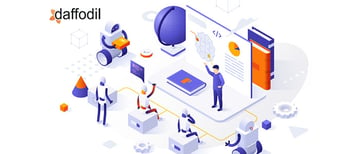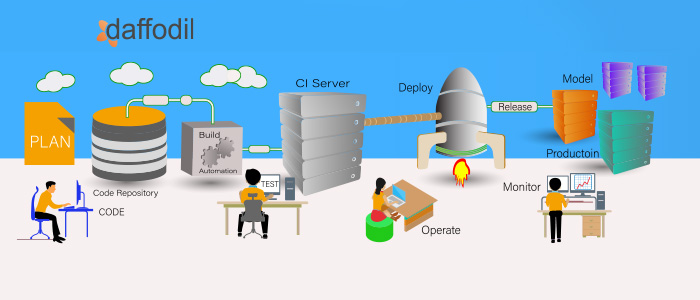
As a Chief Technology Officer (CTO) of an organization, who is either driving the technology team of a startup or leading IT operations in a megacorp; continuously innovating is the goal.
If you’re leading the software engineering cycle of a product or a software development firm, then the struggle to get answers to the following questions must be constant.
- How can we accelerate our delivery cycle?
- How to reduce the time-to-market for a complex development cycle?
- What are the best practices to reduce time to resolution?
Market trend says- DevOps is the answer! It’s a collaborative, product-centric, and automated approach to reducing toil and improving the flow of a software development cycle.
Organizations worldwide are adopting DevOps. It’s the new corporate term.
The following statistics present the evolution of DevOps and its services: 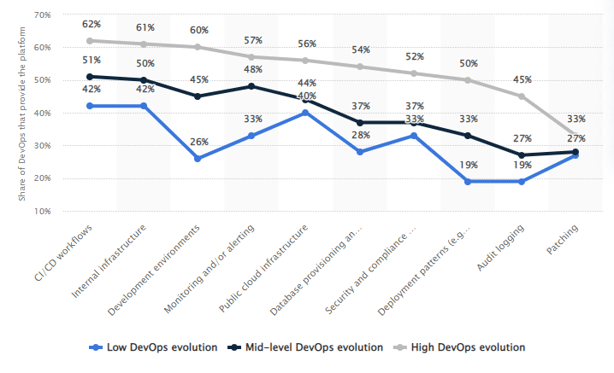
DevOps evolution and self-service offerings adoption | Source: Statista
While some organizations have already implemented DevOps, there are a few who are still planning but are hesitant about a major transition. Gartner predicts that through 2022, 75% of DevOps initiatives will fail to meet expectations due to issues around organizational learning and change.
However, with an execution plan in place, a successful DevOps pipeline can be implemented seamlessly. If DevOps is on the technology roadmap of your organization, then this guide will introduce you to the requisites and ways to get started with it.
Table of Contents
DevOps is Agile but Better!
Is your Organization DevOps Ready?
DevOps Services: What’s Needed to Get Started?
The Barriers to DevOps Implementation
DevOps is Agile but Better!
DevOps is often considered the evolution of Agile. While the fundamentals remain the same- iterative development, collaboration, and rapid releases; DevOps avoids working in silos and involves the operations team to maintain continuity in the development cycle.
If your organization has been adopting the Agile methodology for software development and you wonder - what’s the need to switch to DevOps solutions, then differences in these practices might give you an understanding of why DevOps over Agile.
Agile is an iterative development approach wherein development proceeds in batches (sprints) and involves close collaboration with the stakeholders. The Agile manifesto has four core values:
- Individuals and interactions over processes and tools
- Working software over comprehensive documentation
- Customer collaboration over contract negotiation
- Responding to change over following a plan
DevOps is an approach to building, testing, and releasing software by incorporating automation and collaboration principles. In a traditional Agile approach, operations are missing while the development and operations teams are an integral part of DevOps.
| Agile | DevOps |
| Emphasizes collaboration between development and project management. | Includes operations teams in the development cycle. |
| Focuses on product development flow from ideation and code completion. | Extends the focus to deployment and maintenance. |
| Iterative development in small batches. | Extends focus on test and automation. |
Upfront planning is done for developers. |
Manages unplanned requirements. |
With these differences, we can understand that the priority is DevOps is similar to Agile but is extended to automation, deployment, and bi-directional communication. The benefits of DevOps include (but are not limited to):
- Accelerate Time-to-Resolution
DevOps encourages transparency and seamless communication between teams. With continuous testing of code and feedback, teams can coordinate to resolve issues faster and reduce any delays to push the code to production.
- Faster Time-to-Market
In an SDLC, the development team connects with the IT operations to test the software. For a new software application, the operations team creates a new test environment. For an update in the existing solution, the operations team configures and adds interfaces. This way, the product deployment is dependent upon testing by the operations team, which, in most cases, turns out to be a time-consuming process.
DevOps eliminates this dependency with automated integration for testing. Continuous testing and review cycles significantly accelerate the release to the production cycle.
According to DORA ‘2021 State of DevOps’, the elite performing teams deploy 973X more and 6570X times faster than the low performing teams. For teams deploying frequent releases, DevOps is a better approach to software development than Agile.
- Unplanned Work Management
Unplanned work is the reality of a software development project and is one of the prime blockers to productivity. With tools, processes, and collaborative work culture, anticipating additional or unforeseen tasks and sharing them helps in faster delivery of products. Moreover, for errors and complexities, collaborative culture helps to reduce the meantime to recovery (MTTR) during incidents and outages.
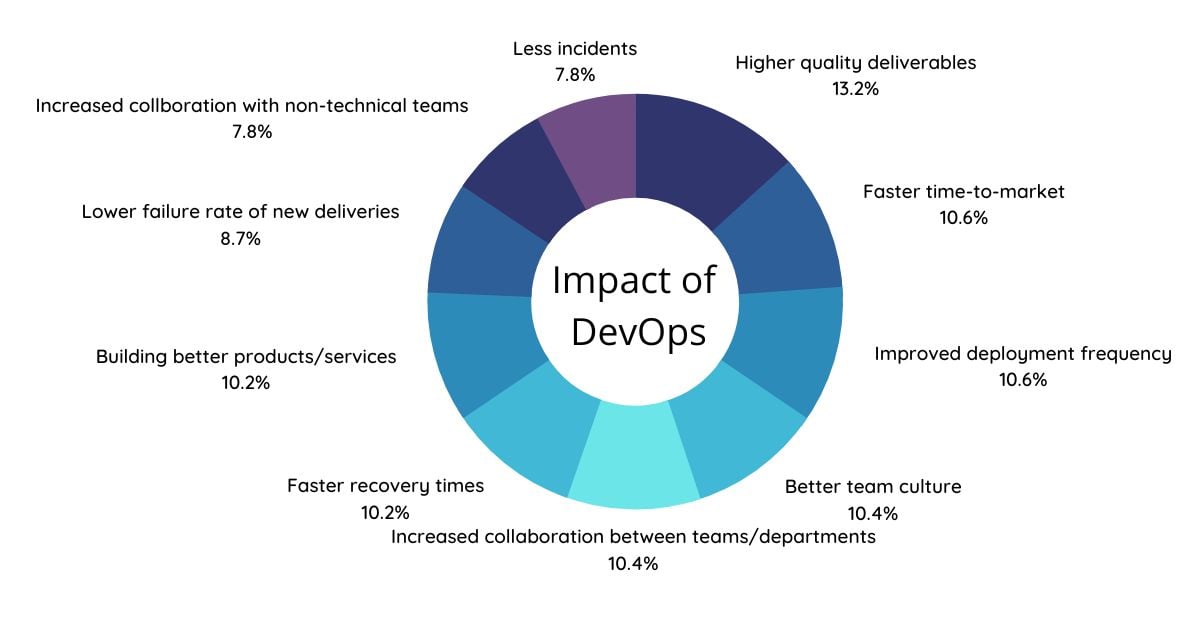
Source: DevOps Trends Survey
Is your Organization DevOps Ready?
The first step to DevOps adoption is to assess if your organization is ready to adopt DevOps. By using the CALMS framework, a CTO can assess a company’s ability to adopt and implement DevOps services. In addition to this, CALMS framework helps organizations measure success during DevOps transformation. It stands for Culture, Automation, Lean, Measurement, and Sharing.
DevOps is a cultural change where collaboration has a key role. This product development approach is known to break the collaboration barriers between the developers and IT/Ops team, solving a major human problem. The DevOps culture leads to the creation of a product-driven team which includes development, QA, design, operations, product management, and other skill sets. If an organization is ready to adopt the culture of shared responsibility, it can adopt DevOps.
Automation of repetitive, manual tasks helps to build reliable systems. DevOps is a technology-driven approach to accelerating and automating product roll-outs. It goes beyond the traditional product development approach that involves manual efforts to test, improve, and deploy software built. When an organization is ready to adopt DevOps, the team members lookout for ways to automate as many tasks as possible and are comfortable with ideas such as Continuous Delivery, Infrastructure as Code (IaC), etc. 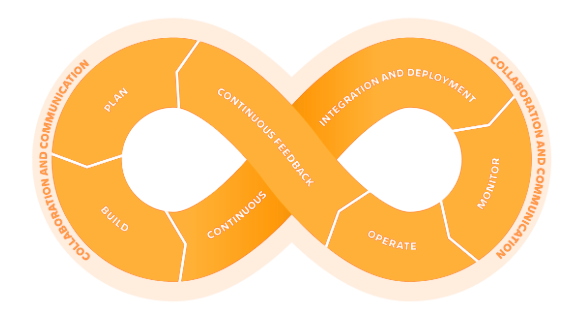
DevOps Automation Cycle
Lean in software development involves eliminating low-value activities (i.e. avoiding manual, repetitive tasks). Also, a DevOps team is able to visualize the work in progress, deliver as fast as possible with quality, amplify learning, etc.
With DevOps practice in place, there are several tools and technologies that help in the measurement of the success of the development process. When there is data, there are mechanisms to have visibility into the systems. DevOps tools for collaboration, security, configuration management, automated testing & deployment allows team members to have clarity on questions like
- How often do recurring bugs or failures happen?
- How long did it take to go from the development to the deployment phase?
- How many users did the product gained or lose in a week or month?
And the last factor to decide if an organization is DevOps ready is sharing. DevOps include a variety of communication channels that helps to create a balance between the development and operations team.
When the 5 pillars of the CALMS framework stand strong, the organization is ready to automate the product development and delivery cycle.
DevOps Services: What’s Needed to Get Started?
There are several support services that an organization needs when transitioning to the DevOps culture. This may include DevOps implementation, assessment & audits, DevOps in the cloud, infrastructure automation, container configuration, etc.
As a CTO of an organization that’s planning to adopt DevOps, it is important to understand the crucial aspects of this project management approach. Let’s understand them in detail.
-
DevOps Implementation
Implementing DevOps does not end by building a CI/CD pipeline. There are several factors associated with it that matter. For example:
Setting up an automation testing environment and executing test scripts to automate testing. This process, called Continuous Testing, helps to obtain immediate feedback on the benefits and risks associated with a release.
To push a tested code to the production server after it goes through rigorous, automated tests, it is necessary to set up a deployment cycle. This process is called Continuous Deployment and it ensures that a new release is live on the production server without human intervention.
To understand the position of DevOps in an organization and what more needs to be done to achieve predefined anticipated results, there is a DevOps maturity assessment.
Implementing DevOps from scratch requires designing a roadmap that has a plan for what needs to be automated and how. This involves setting up a team, tools, infrastructure, cost, etc. A planned transition leads to expected results with minimum or no downtime.
-
ContainerOps
Containers are an inevitable part of a complex software development cycle. The containers contain all dependencies (configurations, system libraries, runtime, code) that help the development teams to work around the limitations of a virtual machine.
An application can have multiple containers and to manage them, there are several container orchestration platforms. Kubernetes, Docker Swarm, Nomad, are some of the orchestration platforms that help to automate configuration, management, and ensure coordination of computer systems, applications, and services.
However, to manage containers with these orchestration platforms, a business might need managed services that would configure these platforms for their best use cases. For that, third-party managed services can be availed, which include:
- Kubernetes managed services
- Container management services
- Container orchestrtaion
- Container security evaluation and hardening, etc.
To simplify container management, there are Container as a Service (CaaS) platforms. These are fully managed platforms to upload, scale, organize, and manage containers using a virtual, container-based environment.
KNOW MORE: What is Containers-as-a-Service?
-
DevOps in Cloud/ CloudOps
CloudOps is the practice of managing the performance and availability of cloud resources to have maximum ROI. This includes maintaining the DevOps services, security of cloud infrastructure, compliances, and making the most of the cloud computing benefits.
When DevOps is implemented in the cloud, several activities need to be performed along with. For example:
Deciding upon a Cloud Architecture Design: A cloud architecture describes how the components and capabilities of the cloud should be connected to build an online platform on which applications run. Architecture is like a blueprint that describes how the capabilities and components would be connected to deliver an application on the cloud.
Performing Cloud Readiness Assessment: This process includes discovering the data and applications that can be moved to the cloud without impacting business operations during the transition. While migrating to the cloud, it is important to analyze compliances, policies, and certifications to ensure that moving data from an on-premise server to the cloud is a seamless and successful process.
READ MORE: How To Assess Readiness Of Cloud Infrastructure?
Performing Cloud Migration: When moving to the cloud, several factors need to be considered. For example,
- How to optimize the cost of cloud resources
- How to avoid vendor lock-in?
- How to automate infrastructure in the cloud?
- What are the best practices for public cloud migration?
Despite several tools available to support the cloud migration cycle, it is necessary to adopt standard practices that lead to the success of the process. These practices could be related to security, data standardization, technical configurations, etc. That is why when thinking of moving data and applications to the cloud, it is always the best idea to have an experienced cloud migration team in place.
-
Automating the Infrastructure
The idea of implementing a DevOps pipeline to automate software development and deployment cycle can be executed on-premise or in the cloud. All that’s needed is the right set of tools to automate deployments.
Infrastructure automation (or scripted infrastructure/configuration management) is the process that enables the development or operations team to manage, monitor, and facilitate resources automatically, without having to manually configure hardware, software, or Operating Systems.
-
Ensuring Security of DevOps Workflows
DevOps pipeline, which comprises several tools & processes needs to be secured in order to have a streamlined development & deployment cycle. Ensuring compliances in the application (GDPR, HIPAA), managing access controls, ensuring container security, and security testing, are some of the ways that can be used to take care of the DevOps pipeline security.
ALSO READ: A DevSecOps Checklist to Secure DevOps Pipeline
The Barriers to DevOps Implementation
DevOps transformations are tricky. There can be several blockers while implementing DevOps in an organization, which could be technical, functional, or simply the skill crunch.
The three major blockers in DevOps implementation are:
Lack of skills in employees: One of the most common barriers in implementing DevOps is the limiting skillset of the team. Finding a capable DevOps team is a tough job for businesses and that is why augmenting the team virtually is becoming a preferred idea these days. Hiring an experienced team of DevOps ensures that you can add on resources for various aspects (CloudOps, automation testing, infrastructure scripting, etc.), as the requirement strikes. 
A DevOps specialist or a DevOps engineer is an IT generalist who holds comprehensive knowledge of the development and operations team. This includes know-how in coding & scripting, infrastructure management, DevOps toolchains, system administration, DevOps advocacy, etc. Apart from the technical skills, a DevOps specialist must have great interpersonal skills as he is responsible to create a collaborative environment.
Legacy infrastructure: Another blocker in seamless DevOps implementation is a legacy infrastructure. Such an infra usually lack minimum requisites to implement CI/CD, version controls, have ad-hocs, which slows down the execution cycle. However, it is important to note that with legacy infrastructure, DevOps could be a little difficult but not impossible.
Adjusting corporate culture: A corporate culture is the foundation of DevOps. For this cultural transformation to happen within an organization, it is necessary for developers and the operations teams to adopt the change in their work cycle. Instead of handling core development and operations tasks, the teams should get into each others’ shoes to get deployments done on time.
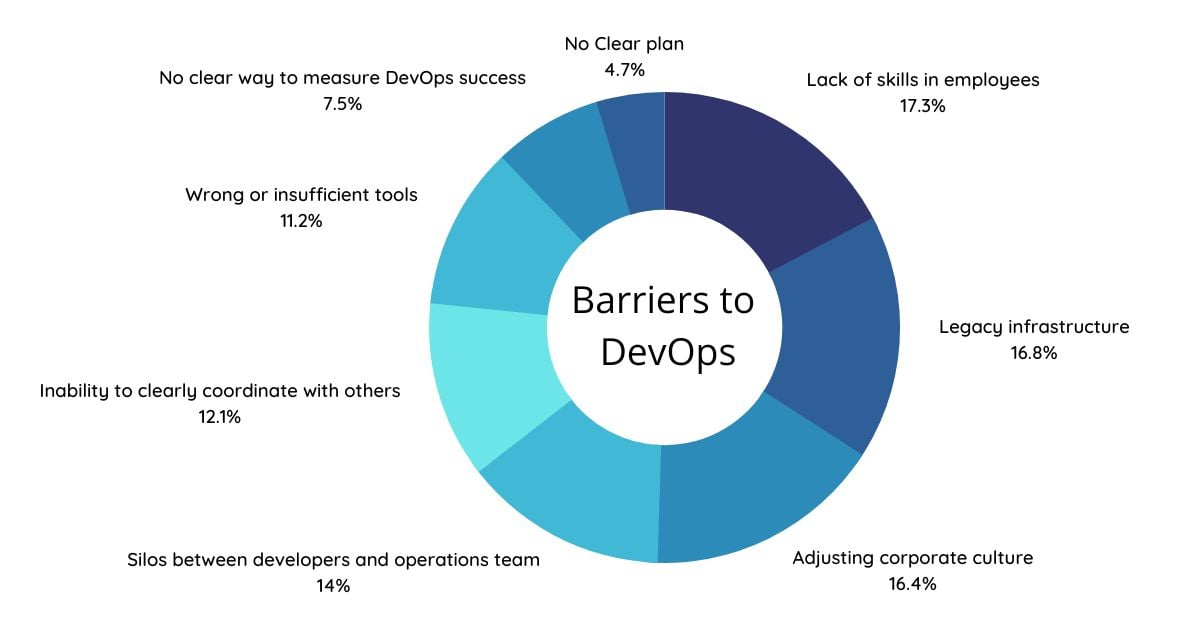
Conclusion:
Transitioning to DevOps is the practice of removing barriers between the two siled teams: development and operations. With the right blend of tools, practices, and cultural philosophies, DevOps enables the development teams to optimize productivity and improve the reliability of operations.
To make the most of DevOps services, its workflow implementation is the key. Having the right execution plan and a skilled team in place can enable teams to work around the challenges of traditional development methods.
At Daffodil, we enable our clients to take the advantage of DevOps and its services. Implementing CI/CD pipeline, migrating to the cloud, designing a multi-cloud strategy, container optimization, are some of the successful practices by our DevOps specialists.
If implementing DevOps is on your mind, then now is the time to get started with it. Our DevOps consultants can guide your way to the execution of DevOps workflows, ensuring that your organization derives maximum advantages by automating the development cycle.






